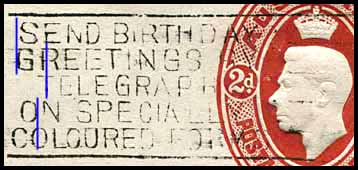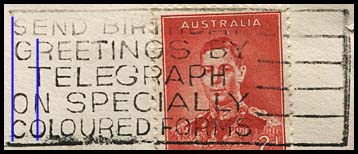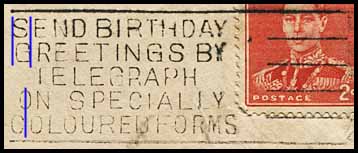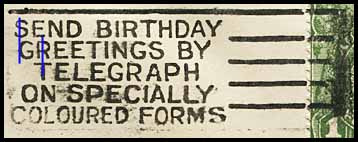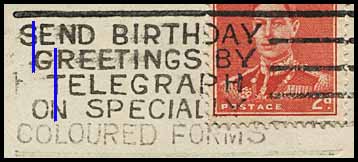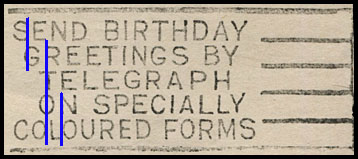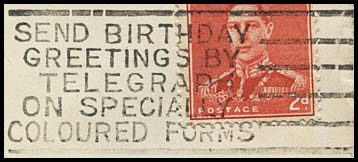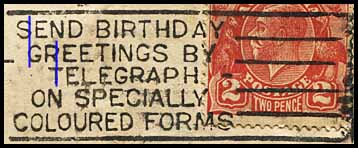Slogan cancellations: Send Birthday Greetings.
- Home, index, site details
- Australia 1901-1988
- New South Wales
- Overview of NSW
- Telegraph lines
- Telegraph Offices
- Date stamps
- Forms
- Envelopes
- Rates
- Stamps
- Queensland
- Overview of Qld
- Telegraph lines
- Telegraph offices
- Date stamps
- Forms
- Envelopes
- Rates
- Stamps
- South Australia
- Overview of SA
- Telegraph lines
- Telegraph Offices
- Date stamps
- Forms
- Envelopes
- Rates
- Stamps
- Tasmania
- Overview of Tasmania
- General developments
- Reports
- Organisation
- Telegraph lines
- Telegraph Offices
- Date stamps
- Railway lines
- Forms
- Envelopes
- Rates
- Stamps
- Overview of Tasmania
- Victoria
- Overview of Vic.
- Telegraph lines
- Telegraph offices
- Date stamps
- Forms
- Envelopes
- Rates
- Stamps
- Ephemera
- Western Australia
- Overview of WA
- Telegraph lines
- Telegraph Offices
- Date stamps
- Forms
- Envelopes
- Rates
- Stamps
A slogan postmark advertising
|
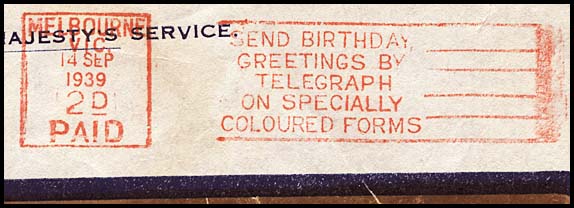 |
was introduced at all main Post Offices except Perth during the week commencing 13 February 1934. The success of the Christmas Greetings forms and the Sydney Harbour Bridge issue led the PMG to extend the range of the ornamental greetings forms in 1934 to other types of ornamental forms - Mothers' Day, Birthday and Congratulations forms. The first format of the Birthday Greetings telegram was probably first issued on 23 September 1934 although an official statement indicated the issue date was 5 November 1934. The second format of the Birthday Greetings telegram was issued in 1939 with a smaller war-time economy size being issued in late 1941 and withdrawn during 1942. |
|
The Send Birthday Greetings .... slogan was used in the five Offices shown below:
The slogan was gradually withdrawn from use - along with all other slogans - starting in the first half of 1940 although a number of 1941 uses are known - especially at Brisbane and Sydney. The postmark was made from chrome steel. It was 20 mm high and 52 mm wide. The slogan formats The Send Birthday Greetings ... slogan appears to be the most inconsistently made slogan of all 11 slogans related to advertising the telegram and telegraph services. Certainly there are the usual variations in terms of shape of date stamp, type and number of box and the inscriptions at the top and base of the date stamp. In addition, they also vary in letter positions and length of lines within and between Offices and across years in many ways which have no consistency - except perhaps for a lack of specification and quality control during the setting process. Sydney is perhaps the Office where most variations occurred and questions must be raised about why the realignment of letters occurred over such short periods. There are also several examples of dies wearing and not printing all letters as intended. No precise classification is therefore possible for this slogan as was possible for the other slogans. It must therefore be a broad classification with sub groups but which still contains variations. Within this restriction, four four categories are suggested for the Send Birthday Greetings ... slogan - in addition to the use of circles or boxes and the inscriptions at the base therein. The variations can be identified by considering:
|
|||||||||||||||||||||||||||||||||||||||||||||||||
|
|||||||||||||||||||||||||||||||||||||||||||||||||
Adelaide:
A progressive error occurred to one of the circle dies in late February 1936. |
 5 November 1935. |
Brisbane:
|
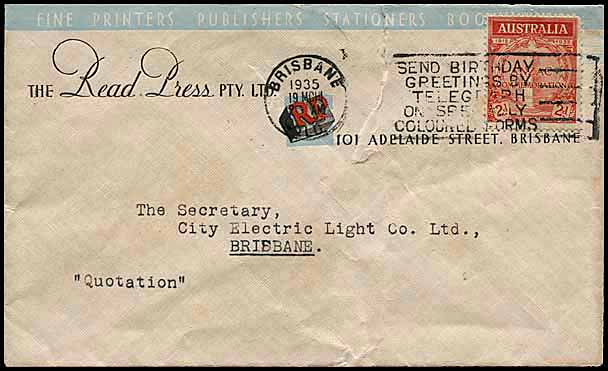 19 March 1935. |
Hobart:
|
 25 July 1938. |
Melbourne:
|
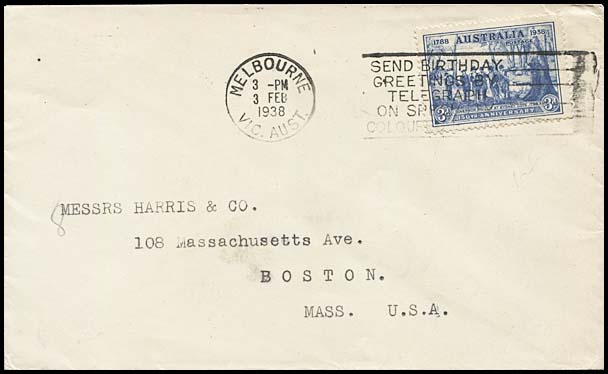 3 February 1938. |
Sydney:
|
 9 April 1935. On a card for a Radio Licence renewal. |
